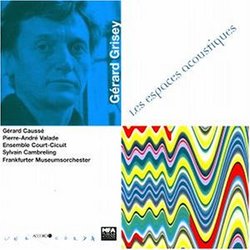| All Artists: Gerard Grisey, Ensemble Court-Circuit, Frankfurter Museumsorchester Title: Gérard Grisey: Les Espaces Acoustiques Members Wishing: 1 Total Copies: 0 Label: Accord Release Date: 10/11/1999 Album Type: Import Genres: International Music, Classical Styles: Europe, Continental Europe, Chamber Music, Forms & Genres, Concertos, Historical Periods, Modern, 20th, & 21st Century Number of Discs: 2 SwapaCD Credits: 2 UPC: 028946538623 |
Search - Gerard Grisey, Ensemble Court-Circuit, Frankfurter Museumsorchester :: Gérard Grisey: Les Espaces Acoustiques
 | Gerard Grisey, Ensemble Court-Circuit, Frankfurter Museumsorchester Gérard Grisey: Les Espaces Acoustiques Genres: International Music, Classical |
Larger Image |
CD Details |
CD ReviewsWarning: may change the way you think about music forever Christopher Culver | 07/29/2008 (5 out of 5 stars) "Gerard Grisey was one of the founders of the spectralist school of composers, who sought a way of writing music based upon the character of sound itself, throwing off the arbitrariness of 12-tone serialism and seeking harmonies even more consonant than common-practice tonality. "We are musicians, and our model is sound and not literature, sound and not mathematics, sound and not theatre, or fine arts, quantum physics, geology, astrology, or acupuncture," Grisey wrote. LES ESPACES ACOUSTIQUES is a cycle of six works the composer wrote early in his career, from 1974 to 1985. They serve as his masterpiece, a credo of the spectralist approach to composition, and they may even change the way you think about music forever.
The cycle begins small, with each movement bringing in ever larger forces, and there's a great deal of theatricality in live performance. In then "Prologue", a solo viola explores variations of a little melodic cell, from the purest overtones to transitions to noise. Grisey pulls so many sounds out of the instrument that its 18-minute length doesn't get tiring at all, but rather leaves the listener awestruck. As the violist completes his piece by playing on an open string, ostentatiously retuning as he walks over to the waiting ensemble, seven players strike up the eery opening notes of "Periodes", the second piece of the cycle. This movement explores the contrasts between clockwork periodicity and more supple rhythms suggestive of human breathing. Musical time was to become the major concern of Grisey's late career, but it was present even here in this earliest of his acknowledged pieces. "Periodes" concludes with a trombone blast, and the ensemble expands to eighteen musicians to make this the first sound of the third movement, "Partiels". This is my favourite of the cycle for its extremely elegant construction. Using a device called a sonogram in the days before computers, Grisey "decomposed" the sound of a trombone playing an E into its constituent parts, comparing their amplitudes (the fundamental is rather quiet, while the fifth and ninth partials are loudest), and then distributing these parts to string instruments playing harmonics. What you have, then, is successive trombone intonations being imitated by a team of other instruments, but in slow motion. This may sound gimmicky, but the result is really a glorious halo of sound. In a concert, there would be an intermission right about now, so everything moves to silence before the next movement, "Modulations" for 33 players. Here everything is "in flux", with the instrumentalists dancing around the overtone spectrum of the low E, with even richer contrasts of periodicity and aperiodicity. Towards the end, all of the sudden an entire orchestra picks up the music, creating a temporary amplification of "Modulations" and leading into the last great part of the cycle, "Transitoires". This awesome movement, with vast batteries of percussion, is rich in polyphonies where spectra are explored as far as the 55th partial. Various performers combine their forces to create synthesizer-like sounds out of mere acoustic instrumentation. The piece winds down with "Epilogue", which returns to the soundworld of "Prologues" but with the forces of a full orchestra and four solo horns. There's also a use of electric guitar (remarkably similar to Gubaidulina's "Zeitgestalten"). Grisey's music is as tonal as can be. It will not necessarily appeal to the conservatives whose preferences run from Bach to Brahms, but nonetheless for open-minded listeners, even those who approach modern music with some trepidation, I cannot recommend LES ESPACES ACOUSTIQUES enough. The organic nature of the music--sounds born out of silence, interacting as if living beings, breathing, expanding, and eventually dying--makes it a soul-stirring work to listen to. It will also encourage one to start paying more attention to issues of tuning in general, which will enable a more richer understanding of music in all its forms, from Western music of the Classical era to exotic indigenious traditions around the globe. Like Per Norgard's Symphony No. 3 with its vision of cosmic unity, Grisey's great cycle gives one an exciting view of a universe in perfect order, after which the listener may never be the same again. Note that there are two extant recordings of LES ESPACES ACOUSTIQUES. This Amazon listing describes an Accord release featuring the Ensemble Court-Circuit, experts in the spectralist school. It is certainly the recording to get. There's another recording on Kairos, but I find the work less confidently performed there." |
